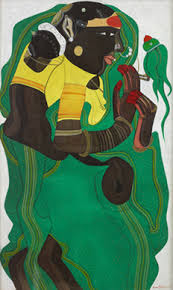Classical Physics has a fundamental flaw. It deducted
everything into parts and theorized that knowing the part was equivalent to
knowing the whole. The dynamics of the part could be extrapolated to the
dynamics of the whole. Any complex system could be analysed by splitting it
into its basic constituent parts. Take the Universe and divide it into matter,
subdivide it into element and then into particles . Analyse the particles and
extrapolate the result. Lo, you have the Universe in your hands! This is equivalent
to saying that if you know the geography of a region, you can map the Earth.
The Greek philosopher Democritus set the ball rolling with his followers
Galileo, Descartes and Newton giving it further momentum. The Universe was
deducted into a huge, mechanical clock. The Sat or Unma part of the Universe
was never taken into account. The life was taken away from the body.
 |
| Valsan Kolleri |
Modern physicists don’t negate the ‘part’, however. They
suggest the reverse order, i.e., from the ‘Whole’ to the “Part’. You've got to
know about the ‘whole’ first in order to gain knowledge about the ‘part’.
“Whole” is first and foremost. (Strictly speaking there is no such thing as the
‘part’. Everything is a pattern … interconnected, interdependent and
inseparable). A web of life, in essence. Even the most mundane events of our
day-to-day life is affected, some way or other, to a happening in the Universe.
The disappearance of galaxies at the far-end of the Universe does make an
effect in our lives. In short, there is no stand-alone event anywhere.
 |
If process and phenomena are interconnected and
interdependent, it becomes a pre-requisite to know all. As we are all aware,
this is just impossible. In other words, our knowledge about the Universe will
always remain incomplete. This is the perennial constraint of knowledge
acquired through physical sciences. Vedantins call this ‘avidya’ and prescribes
methods to overcome it. According to Vedanta, avidya too is anadi (without a
beginning). Avidya is not to be condemned but to be won over using
nitya-anitya-viveka (wisdom segregating the real from the illusionary) and
pourusha (will-power and steadfastness).
 |
| Valsan Kolleri |
This is beautifully depicted in sculpture…the famous dance
of Nataraja. Muyalakan on which the Lord dances is avidya itself. One has to
get rid of ignorance and illusions. Seek the one which is real and everlasting.
In spite of the level of ignorance you are in, even at the rock-bottom, there
exists an escape-route.
Of course, nobody asks you to take the route. It is
optional. It is okay if you don’t go the Vedanta way. Still, there is so much
to learn from Systems Thinking. The new-age philosophy evolved from Modern
Physics is an eye-opener.
In an unequal world where 75% of the natural
resources are controlled and utilized by 20% of the total population, 80% of the
wealth created is stashed away by the same minority, 25% of the humanity has to
make do with less than two square meals per day, it is completely unethical to
use technology for selfish ends. It should be used for greater common good. We have the illustrious example of Madame Curie, the only one to have won Nobel prize for both Physics and Chemistry (in 1903 and 1911 respectively), refusing to patent her own inventions for the benefit of all. That's the real spirit !
The new-age philosophy urges us to
keep an honest and humble affinity towards Man and Nature. In fact Man and
nature are not separate. They are one and the same.
 |
| Valsan Kolleri |
The differences and contradictions that we experience are
relative. It occurs due to the particular nature of human thought- process. If
a thought originates from A to B, another thought opposing the first originates
simultaneously from C to B. When we think about beauty, we also think about
ugliness. Good & bad, pleasure & pain, Life & Death are two sides
of the same reality. A good human-being does not mean a person full of virtues
only. It means a person who keeps sustainable balance between virtue and evil for
his/her own benefit as well as for others’.
Acknowlegements
1.Shri.P.Kesavan Nair for his books “Bhouthikathinappuram”
and “Vipareethangalkkappuram”
2.Swami Kaivalyananda for his talks on Upanishads
3. Radhakrishnan Sir, Scientist for his inputs in Modern
Physics
